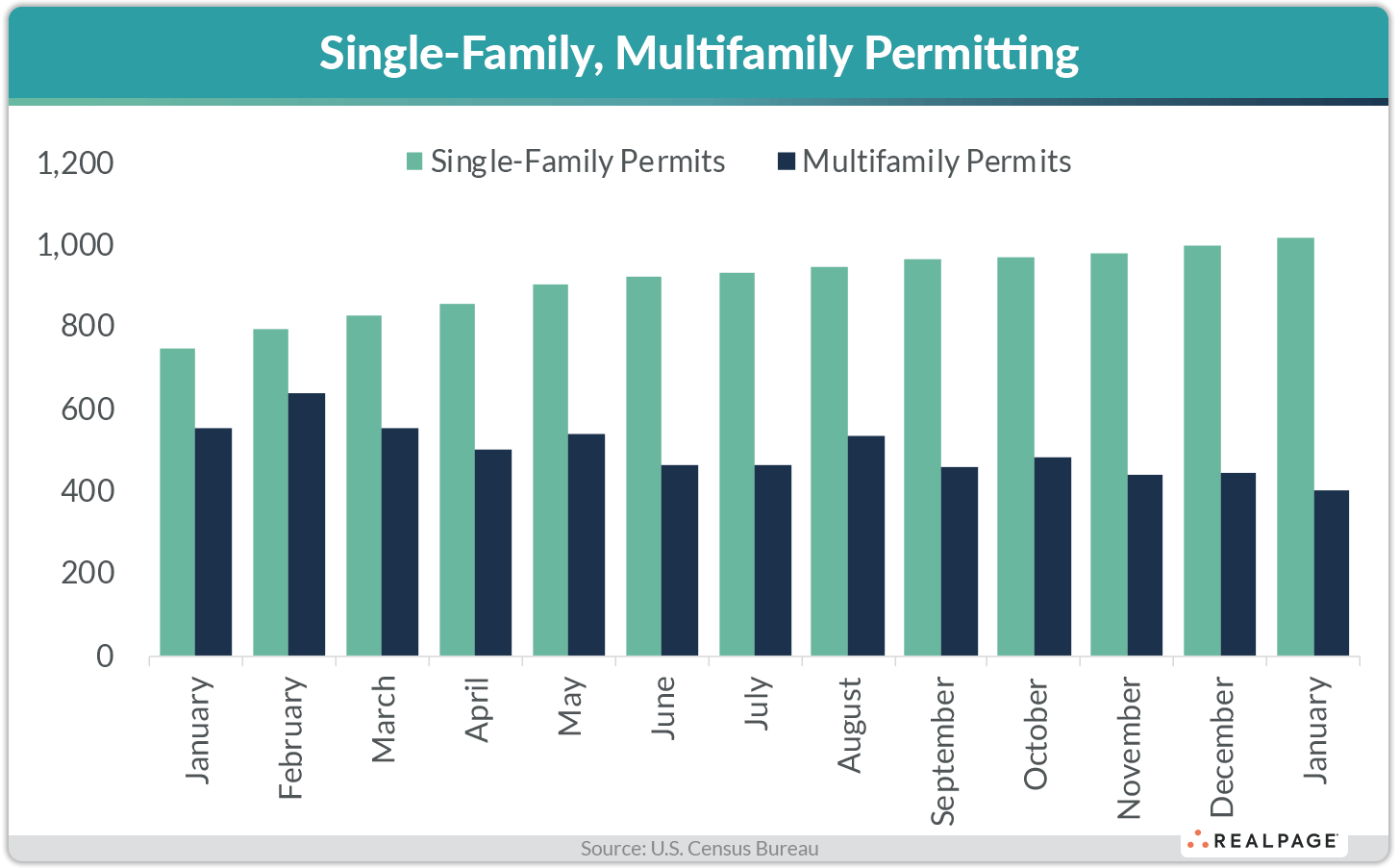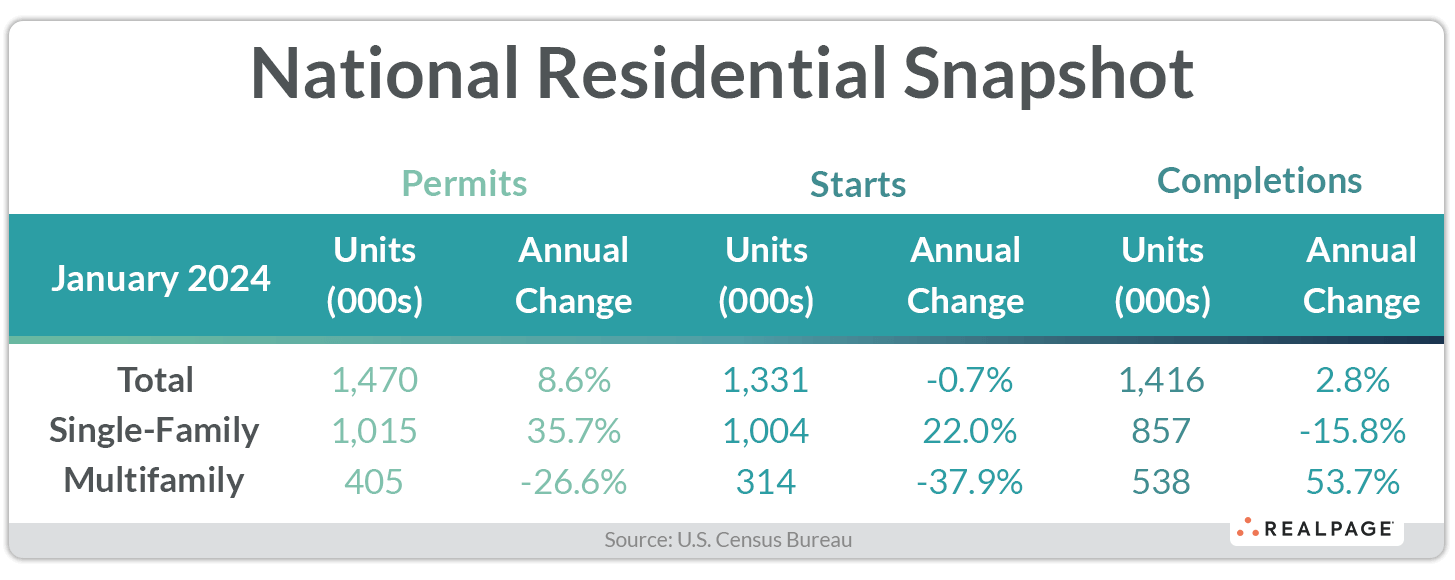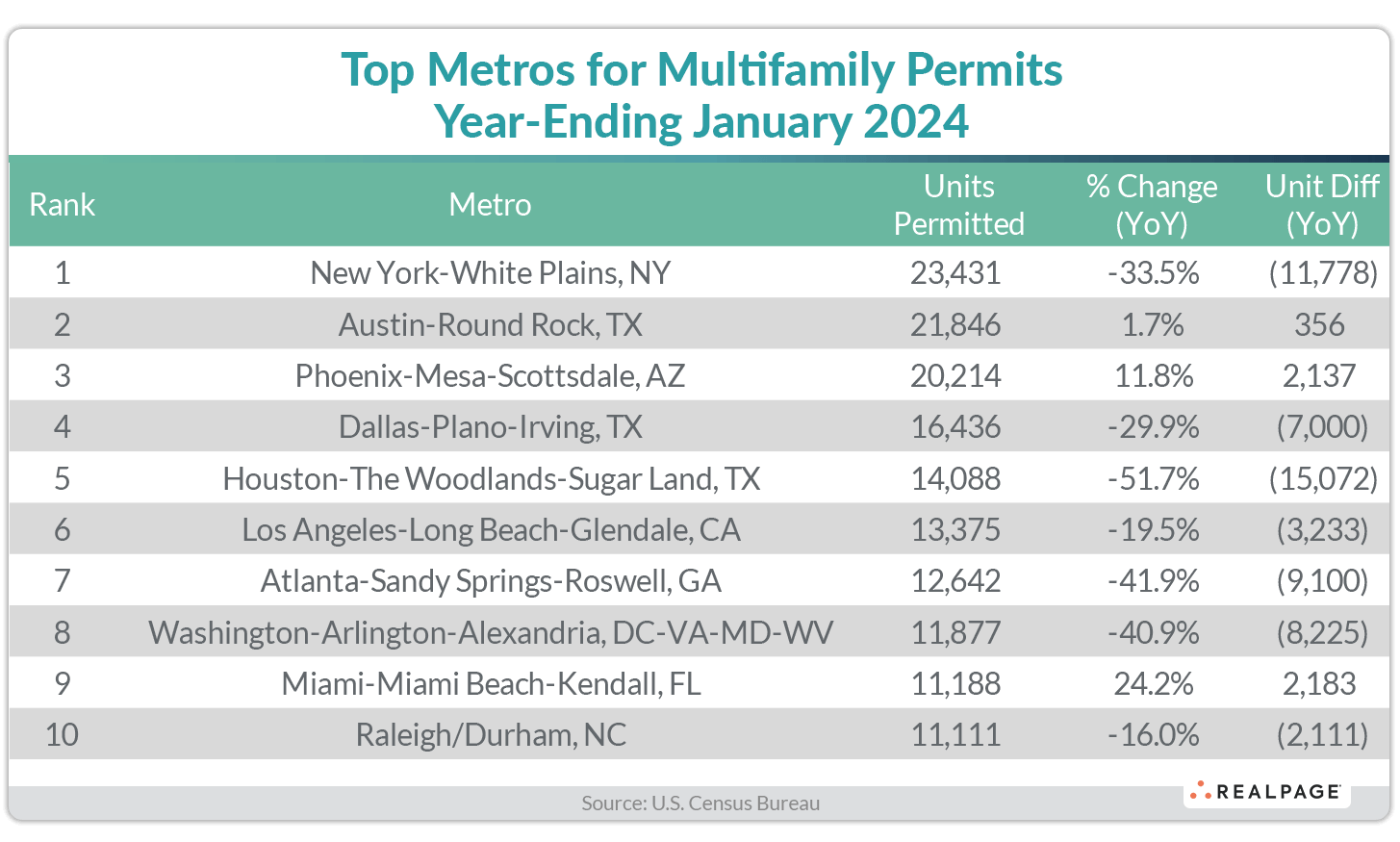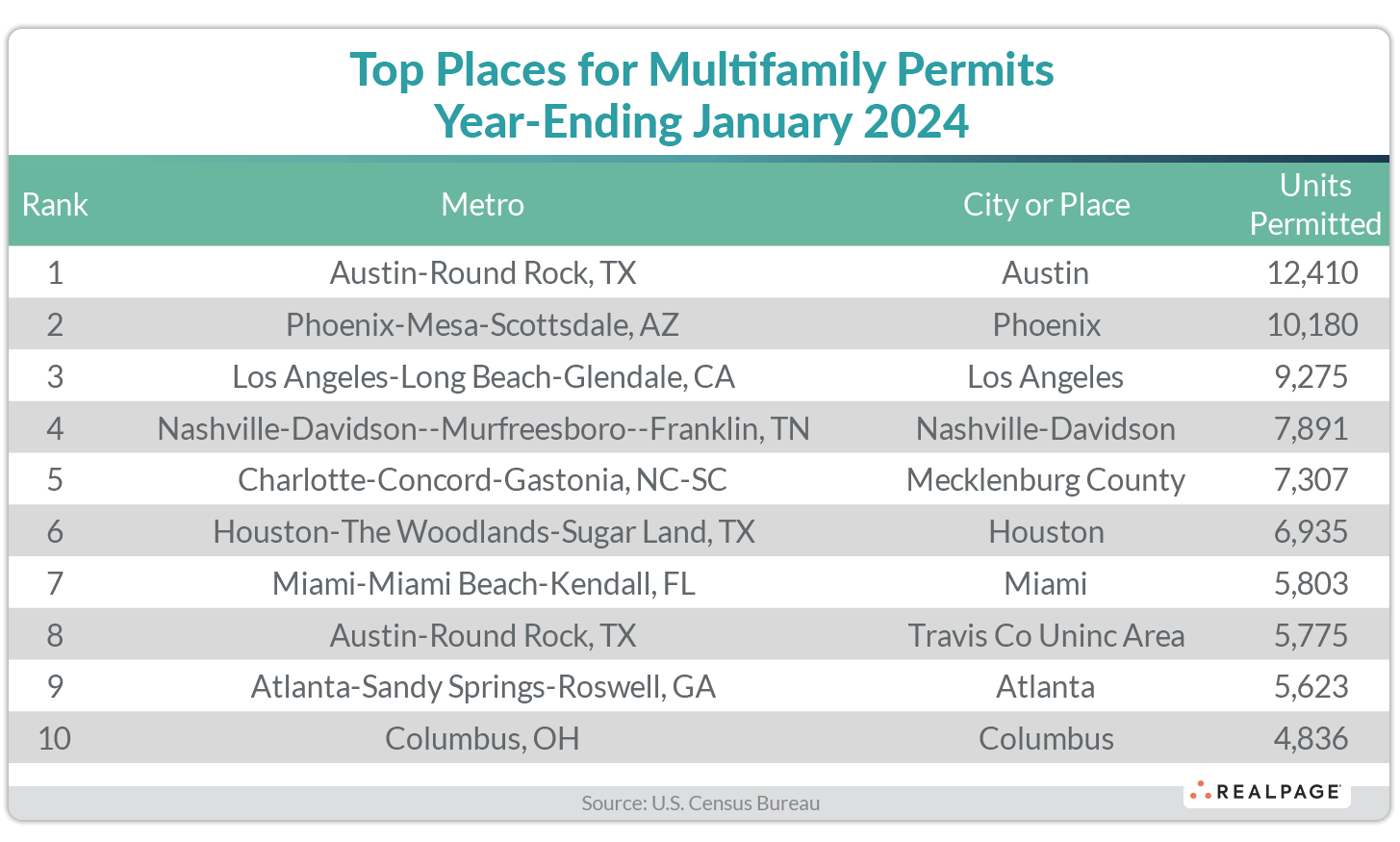Multifamily permitting and starts continued to slow in January, while single-family volumes extended the upward trend started in late 2022.
The seasonally adjusted annual rate (SAAR) for multifamily permitting decreased 9% from December’s rate and was down almost 27% from last year, falling to 405,000 units, according to data from the U.S. Census Bureau. Multifamily starts were down 35.8% from last month and fell 37.9% from last January to 314,000 units.
Meanwhile, single-family permitting edged up 1.6% from December to 1.015 million units, an increase of 35.7% from last year. Single-family starts dipped 4.7% for the month but were up 22% for the year at 1.004 million units. Despite higher mortgage rates and elevated home prices in many markets, the single-family market continues to expand.
Completions of multifamily units were up 6.3% from December to 538,000 units and increased 53.7% from last January. The number of multifamily units under construction slipped 0.9% from December at 979,000 units but are up 5% from last year. Additionally, the number of multifamily units authorized but not started was up 2.6% at 120,000 units in January but were down 24.5% from one year ago.
Single-family completions were down 16.3% for the month and 15.8% for the year to 857,000 units. The number of single-family units under construction was virtually unchanged at 680,000 units but that was 9% less than one year ago. Single-family units authorized but not started inched up 1.4% from December and were up 5.2% from last January at 142,000 units.
Together with the small 2 to 4-unit figures, total residential permitting ticked down 1.5% from last month but increased 8.6% for the year to 1.470 million units. January’s large decrease in annual multifamily starts brought the SAAR of total residential starts down 14.8% from last month to 1.331 million units and they were essentially unchanged from last year.
Compared to one year ago, the annual rate for multifamily permitting decreased in two of the four Census regions, with the deepest decreases in the South (down 39.5% to 183,000 units) and West (down 25.7% to 99,000 units) regions, while the Midwest (up 6.9% to 78,000 units) and Northeast (up 2.2% to 47,000 units) regions had moderate increases. Compared to the previous month, permitting was up in all but the South region.
Multifamily starts fell sharply in the small Northeast region (down 61.5% to 25,000 units) and were down significantly in the West (42.7% to 95,000 units) and South (31.5% to 171,000 units) regions. The Midwest region saw a moderate decrease of 12.8% in starts to 24,000 units. Compared to December’s SAAR, starts were down in all four Census regions by at least 23%.
Metro-Level Multifamily Permitting
Nine of the top 10 markets from December’s list returned in January with only three remaining in order.
After being edged out last month for the number one spot, New York regained the lead for multifamily permitting in the year-ending January with 23,431 units permitted, down by a third from last year. Austin slipped back to the #2 spot, permitting 21,846 units for the year, but that was an increase of 356 units from last year.
Phoenix, Dallas and Houston remained in the #3 to #5 spots, but Phoenix’s 20,214 units permitted included an increase of almost 12% from last January, while Dallas (16,436 units permitted) and Houston (14,088 units permitted) were down significantly (30% to 52%, respectively).
Los Angeles and Atlanta changed places at #6 and #7 in January with Los Angeles’ 13,375 units permitted down almost 20% for the year while Atlanta’s 12,642 units permitted were down almost 42%. Washington, DC moved up a spot to #8 with 11,877 units permitted, also down more than 40% from last January.
Miami jumped onto the top 10 list at #9, permitting 11,188 units for the year, an increase of 2,183 units or 24.2%. Raleigh/Durham slipped to the #10 spot with 11,111 units permitted, down 16% for the year.
Only three of the top 10 multifamily permitting markets increased their annual totals from the year before and the size of the increases ranged from a minimal 356 units in Austin to more than 2,100 units each in Phoenix and Miami. On the other side, Houston had the largest decrease in annual multifamily permitting of the top 10 (-15,072 units), followed by New York (-11,778 units), Atlanta (-9,100 units) and Washington, DC (-8,225 units). Dallas, Los Angeles and Raleigh/Durham had significant declines in multifamily permitting as well.
Other major non-top 10 markets with significant declines in permitting include San Antonio (-6,230 units), Minneapolis/St. Paul (-6,226 units), Seattle (-6,214 units), Tampa (-4,528 units), Boston (-3,386 units), Denver (-3,131 units) and Fort Worth (-3,119 units).
Major markets with significant increases in the year-ending January were Nashville (+7,822 units), Greensboro/Winston-Salem (+3,325 units), Riverside (+2,855 units), Charlotte (+2,720 units) and San Diego (+2,106 units).
The annual total of multifamily permits issued in the top 10 metros – 156,208 – was about 25% less than the 208,051 issued in the previous 12 months and down about 1.4% from last month. The total number of permits issued in the top 10 metros was almost equal to the number of permits issued for the #11 through #32 ranked metros.
Below the metro level, nine of last month’s top 10 permit-issuing places returned to this month’s list with only two remaining in the same place and the rest changing places. The list of top individual permitting places (cities, towns, boroughs and unincorporated counties) generally include the principal city of some of the most active metro areas.
In January, the city of Austin remained in the #1 position with 12,410 units permitted, 665 more units than in December. The city of Phoenix moved up to the #2 spot in January with 10,180 units permitted, 950 more than last month. The city of Los Angeles moved down one to #3 with 9,275 units permitted, about the same as last month.
The city-county of Nashville-Davidson and Mecklenburg County (Charlotte) each moved up one spot to #4 and #5, displacing the city of Houston to the #6 spot. Nashville-Davidson (7,891 units permitted) and Mecklenburg County (7,307 units permitted) were each down only about 150 units from last month’s annual totals, while Houston (6,935 units permitted) dropped by more than 1,800 units.
The city of Miami (5,803 units permitted) jumped two spots to #7 in January, up 624 units from December. Unincorporated Travis County (Austin) remained in place from last month at #8 and was almost unchanged with 5,775 units permitted.
The city of Atlanta slipped two spots to #9 with 5,623 units permitted, down 761 units from December’s annual total, while the city of Columbus joined the top 10 with 4,836 units permitted, up 646 units from December.











